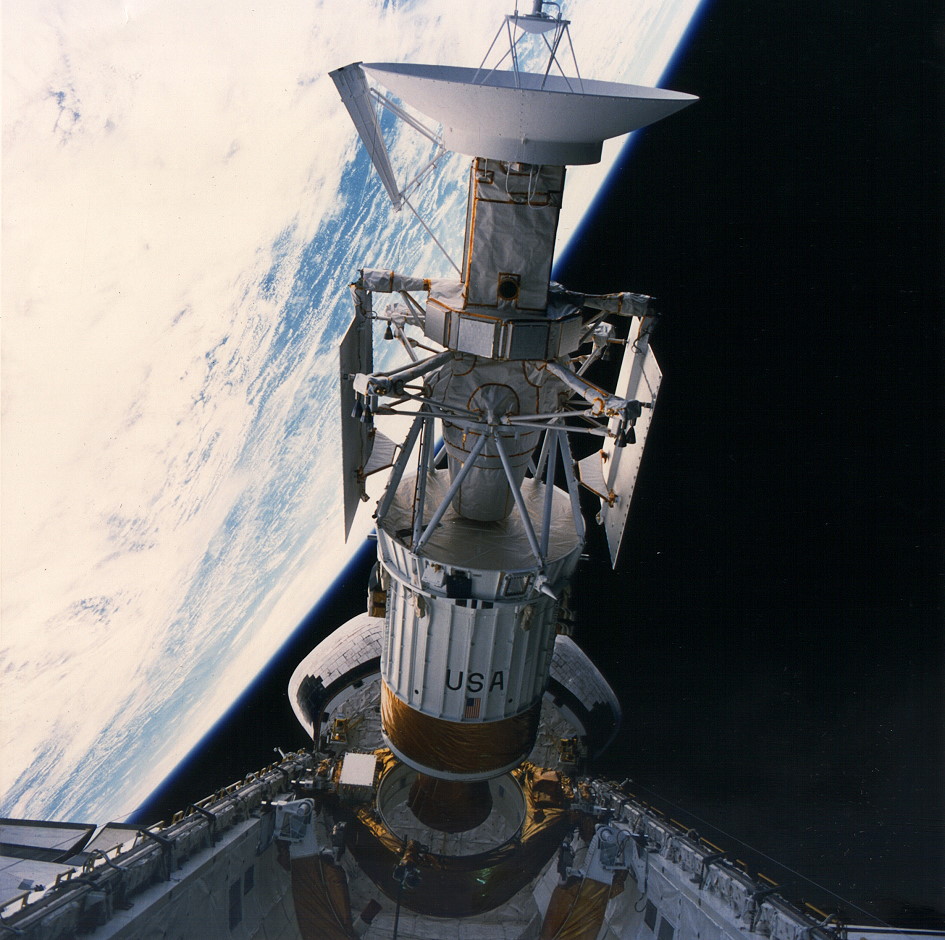
Twenty-five years ago this week, in May 1989, Shuttle Atlantis thundered into orbit on a remarkable mission which would unveil the planet Venus—nicknamed Earth’s “twisted sister”—in a wholly new light. During their four days in space, the STS-30 crew of Commander Dave Walker, Pilot Ron Grabe, and Mission Specialists Mark Lee, Norm Thagard, and Mary Cleave deployed NASA’s Magellan spacecraft on a 15-month voyage to Venus. Following its arrival at the mysterious, cloud-shrouded world in August 1990, Magellan spent four years mapping over 98 percent of Venus’ surface using powerful synthetic aperture radar.
Not since the Pioneer Venus Orbiter mission in 1978 had anything bearing the Stars and Stripes drawn close to the strange planet, which is so close to our world in terms of proximity and physical size, and yet so acutely different in terms of temperature and atmospheric structure, composition, and pressure. Since the early 1960s, it was known that radar imaging technologies could acquire crude images of the Venusian surface, and it was these which helped to peg the planet’s sidereal day at 243 Earth-days—longer than its 224-day “year”—and ascertain the retrograde nature of its rotation. By the end of the 1970s, efforts got underway to build a Venus Orbiter Imaging Radar to gaze beneath the haze of the planet’s thick atmosphere and gain clearer insights into the nature of its surface. Unfortunately, this mission exceeded NASA budget constraints and was cancelled in 1982.
The idea retained its importance, however, and a stripped-down version was recommended by the Solar System Exploration Committee and was accepted under the new name of “Venus Radar Mapper” (VRM) in 1983. Two years later, it was renamed “Magellan,” in honor of the 16th-century Portuguese explorer Ferdinand Magellan, who mapped and circumnavigated the globe, just as his mechanized namesake would someday do for Venus. In the months before the January 1986 loss of Challenger, Magellan was manifested to be launched atop a Centaur-G Prime booster from shuttle mission STS-81I in April 1988. After deployment from the shuttle, it would follow a so-called “Type I Heliocentric Orbit” trajectory, carrying it 180 degrees around the Sun to rendezvous with Venus in four months.
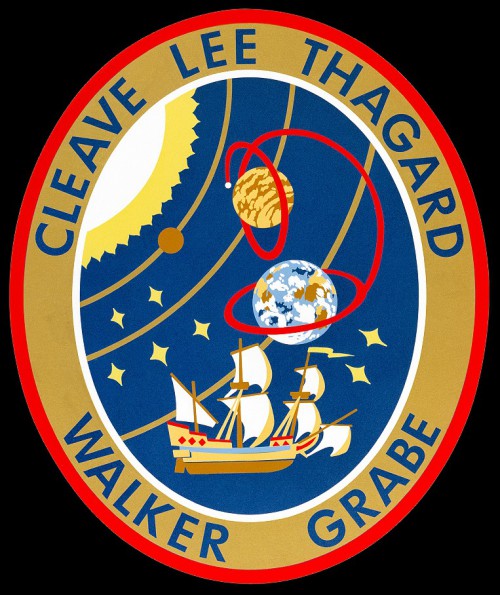
During its subsequent mission, Magellan would dwarf the achievements of its predecessors. The Pioneer Venus Orbiter and earlier Soviet Venera spacecraft had mapped a relatively tiny portion of the planet’s surface. Built by Martin Marietta, with mission management from the Jet Propulsion Laboratory (JPL) in Pasadena, Calif., Magellan would create the most comprehensive map of Earth’s twisted sister in history: A staggering 92 percent of the surface would be scrutinized by its powerful radar. Costing $295 million, Magellan was built from spare parts of earlier missions, including Voyager, Galileo, and Ulysses. Physically, the spacecraft comprised a decahedral, three-axis-stabiliZed equipment “bus,” measuring 1.4 feet (42.4 cm) high and 6.5 feet (2 meters) in diameter and weighing 7,600 pounds (3,450 kg). It was dominated by a large parabolic, dish-shaped antenna, composed of strong graphite-epoxy sheets mounted to an aluminum-honeycomb structure. This device measured 12 feet (3.7 meters) in diameter and actually served two purposes: high-gain communications with Earth and as the synthetic aperture radar to map Venus’ surface. A pair of square, paddle-like solar panels, each measuring 8.2 feet (2.5 meters), supplied electrical power.
Insertion into orbit around Venus was to be accomplished by a Star-48 solid-rocket motor. Although Magellan’s high-gain antenna was ideal as a communications tool, it was uncommon as a synthetic aperture radar, which is normally much larger and can be directed without physically moving the spacecraft. Since the antenna was rigidly attached to Magellan, continuous attitude control was required during mapping cycles to image the planet’s surface and transmit data back to Earth. Attitude control was by a propulsion module of 24 hydrazine-fed thrusters and a set of reaction wheels. Magellan would point its antenna at Venus whilst passing the low point in its highly elliptical orbit, taping the data, and then as it climbed to the high point of its orbit would turn to replay the tape to Earth. In fact, it made around 3,000 changes to its operating mode during each mapping period, many of which were repetitive and were stored in the memory of its twin computers.
Magellan’s April 1988 launch window evaporated in the months after the Challenger tragedy. It would have been boosted by the “Centaur-G Prime,” a thin-skinned, liquid-fueled rocket which many astronauts and engineers condemned as unsafe and unacceptable to use in conjunction with a piloted shuttle flight. Measuring 29.5 feet (9 meters) long and 13.1 feet (4 meters) in diameter, the Centaur-G Prime was nicknamed a “balloon tank,” because its rigidity depended upon full pressurization. It had long been viewed warily by NASA’s safety management, whose rule of thumb in shuttle operations had always been that no single failure point could be capable of endangering the vehicle or crew.
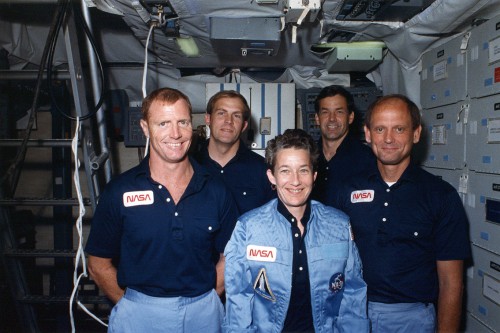
The Centaur-G Prime did more than that. Much of its pressure regulation hardware was non-redundant, and, worse, a failure of its internal bulkhead had the potential to rupture both its liquid oxygen and hydrogen tanks. Additionally, it was recognized that the sheer mass of propellants—which totaled more than 36,380 pounds (16,500 kg)—could induce “sloshing” and a myriad of other controllability problems that could hinder the shuttle pilots if the need arose to perform a Return to Launch Site (RTLS) abort shortly after liftoff. In spite of the hazards, the Centaur-G Prime’s key advantage was that its liquid propellants provided considerably more oomph to push large payloads out of Earth orbit and onto trajectories to other planets than solid-fuelled rockets could achieve. It was also known that liquid-fed boosters produced a much “gentler” thrust than the notoriously harsh impulse of solid-fed ones, like Boeing’s Inertial Upper Stage (IUS). Still, the safety concerns rightly overshadowed and ultimately overwhelmed these benefits.
The booster’s first two NASA shuttle passengers were the Ulysses solar explorer and the Galileo Jupiter orbiter and atmospheric-entry probe, both scheduled to fly on two separate missions (STS-61F and 61G) within a single, week-long “launch window” in May 1986. As described in a previous AmericaSpace history article, astronaut Rick Hauck, 61F’s commander, expressed serious concern about the lack of redundancy. “Rockets that are associated with human spaceflight have certain levels of redundancy and certain design specifications that are supposed to make them more reliable,” he told the NASA oral historian, years later. “Centaur did not come from that heritage, so, No. 1, that was going to be an issue in itself, but No. 2 is that if you’ve got a Return to Launch Site abort or transatlantic abort and you’ve got to land, and you’ve got a rocket filled with liquid oxygen and liquid hydrogen in the cargo bay, you’ve got to get rid of it. That means you’ve got to dump it while you’re flying through this contingency abort.
“To make sure that it can dump safely,” Hauck continued, “you need to have redundant parallel dump valves, helium systems that control the dump valves [and] software that makes sure contingencies can be taken care of. Then, when you land, you’re sitting with the Centaur in the bay that you haven’t been able to dump all of it, so you’re venting gaseous hydrogen out this side [and] gaseous oxygen out that side. This is just not a good idea!”
Originally, Hauck’s 61F flight to deploy Ulysses on its journey to the Sun was scheduled to launch aboard Challenger on 15 May 1986, spending four days aloft, before touching down at the Shuttle Landing Facility (SLF) at the Kennedy Space Center (KSC), Fla. Less than 24 hours later, on 20 May, her sister ship Atlantis would roar into orbit with another crew, commanded by veteran astronaut Dave Walker, to launch Galileo toward Jupiter. The 61G mission would also last four days, landing on the 24th.
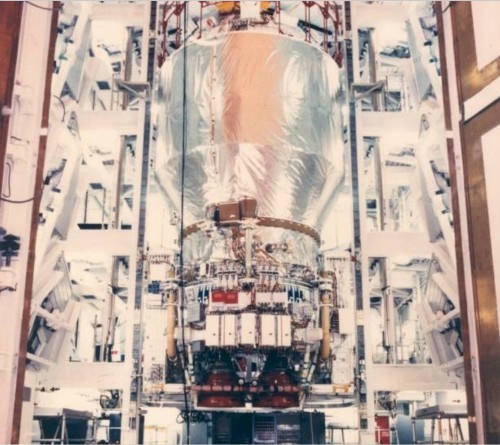
To support the Centaur-G Prime, both Challenger and Atlantis underwent extensive modifications, costing around $5 million apiece, which included extra plumbing to load and drain the Centaur’s propellants and control panels in their aft flight decks to monitor its performance. A Centaur Integrated Support Structure (CISS) at the rear of the payload bay would have held the booster and its payload and oriented them for deployment. As NASA’s newest orbiter, Atlantis had been made Centaur-capable during her initial construction and was destined to spend the first part of 1986 out at Pad 39B undergoing validation tests of the new hardware. Challenger, too, had received the Centaur upgrades, which also included an S-band transmitter to handle the booster’s telemetered data.
During pre-launch loading operations, the Centaur-G Prime’s liquids would have been fed through plumbing tapped into the shuttle’s main propulsion system. Emergency dumping vents—capable of draining all liquid oxygen and hydrogen from the booster within 250 seconds of an abort being declared—were situated on opposite sides of the aft fuselage, just beneath the Orbital Maneuvering System (OMS) pods. As part of her validation tests, Atlantis would have rolled to Pad 39B in February 1986 with a real Centaur-G Prime and a mockup of Galileo in her payload bay. Whilst on the pad, the booster would have been fueled and a series of tests carried out. Atlantis would then have been removed from the pad to enable the real spacecraft to be installed and then she would be rolled out to Pad 39A. By mid-April, she would have been joined on Pad 39B by Challenger, laden with Ulysses and its own Centaur.
All of this discussion of the 61F and 61G missions offers a tantalizing glimpse of what might have awaited Magellan had it flown atop its own Centaur-G Prime on Mission 81I on 6 April 1988. To save weight, as with the Ulysses and Galileo missions, there would be no secondary experiments and Atlantis’ payload bay for 81I would have been empty, save for Magellan itself and the Centaur and its support structure. Even some crew equipment in the middeck, including the galley, would have been eliminated to save weight. Moreover, assuming an on-time liftoff of 81I, the crew would likely have had no more than a few hours to get Magellan out of Atlantis’ payload bay and on its way to Venus, since the Centaur was required to periodically dump its boiled-off gaseous hydrogen to keep tank pressures within mandated limits. After too much time, it would have “bled” so much hydrogen that the remainder would not be sufficient to perform its trans-Venus “burn.”
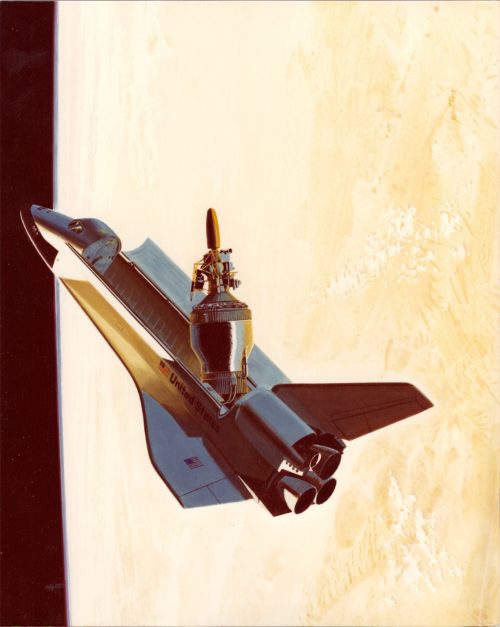
With 20-20 hindsight, it has often been argued that the danger signs posed by Solid Rocket Boosters (SRBs) and the Centaur-G Prime were visible and apparent, long before Challenger’s final, fateful mission. In the event of an RTLS abort during ascent, it was not possible to vent the Centaur’s propellant overboard, risking an explosion in the payload bay … and, according to astronaut John Fabian, sloppiness on the part of the processing workforce heaped additional worries. Fabian even remembered seeing one technician clambering onto the Centaur with an untethered wrench in his back pocket, whilst another tried to smooth out a weld and accidentally scarred the skin of the upper stage. Yet 61F mission specialist Mike Lounge rationalized their thinking. “We assumed we could solve all these problems,” he said. As if to underline the point, the 61F crew were in a flight procedures meeting on the morning that Challenger exploded, reviewing the techniques to vent the Centaur’s propellants in the event of a launch abort. “We were still basically bulletproof. Until Challenger, we just thought we were bulletproof and the things would always work.”
Only days after the 28 January 1986 loss of Challenger, the first echo was heard for what would turn into a death-knell for the Centaur-G Prime. KSC’s safety office refused to approve advanced processing of the first Centaur-G Prime, citing “insufficient verification of hazard controls” from both NASA and the booster’s manufacturer, General Dynamics. Additional safety concerns, and cost overruns to the tune of $100 million, ultimately led to the project’s cancellation in June 1986. When Galileo and Ulysses were finally launched several years later, sans Centaur, they did so in separate “windows.” Galileo flew aboard STS-34 in October 1989, followed by Ulysses aboard STS-41 in October 1990.
The cancellation of the Centaur-G Prime came as a hammer-blow for the Magellan project, for if the mission was to continue it would require a new booster to carry it across the vast interplanetary gulf from Earth to Venus. In addition to a new booster, the solution encompassed a radically different trajectory design.
The second part of this article will appear tomorrow.
Want to keep up-to-date with all things space? Be sure to “Like” AmericaSpace on Facebook and follow us on Twitter: @AmericaSpace



